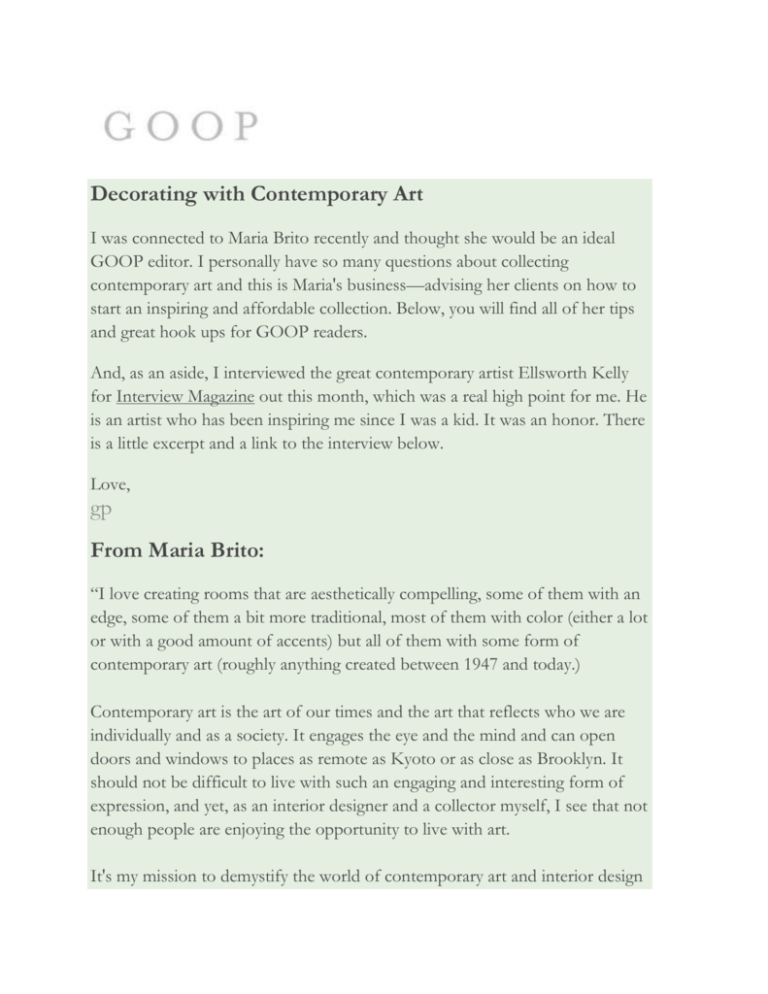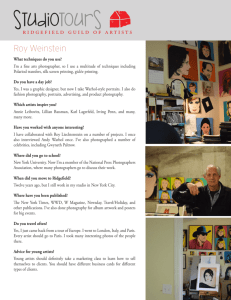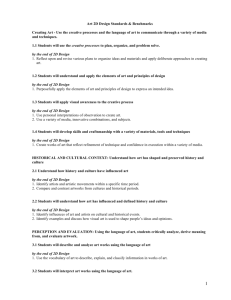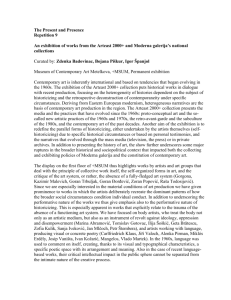GOOP Newsletter – Decorating with Contemporary Art
advertisement

Decorating with Contemporary Art I was connected to Maria Brito recently and thought she would be an ideal GOOP editor. I personally have so many questions about collecting contemporary art and this is Maria's business—advising her clients on how to start an inspiring and affordable collection. Below, you will find all of her tips and great hook ups for GOOP readers. And, as an aside, I interviewed the great contemporary artist Ellsworth Kelly for Interview Magazine out this month, which was a real high point for me. He is an artist who has been inspiring me since I was a kid. It was an honor. There is a little excerpt and a link to the interview below. Love, gp From Maria Brito: “I love creating rooms that are aesthetically compelling, some of them with an edge, some of them a bit more traditional, most of them with color (either a lot or with a good amount of accents) but all of them with some form of contemporary art (roughly anything created between 1947 and today.) Contemporary art is the art of our times and the art that reflects who we are individually and as a society. It engages the eye and the mind and can open doors and windows to places as remote as Kyoto or as close as Brooklyn. It should not be difficult to live with such an engaging and interesting form of expression, and yet, as an interior designer and a collector myself, I see that not enough people are enjoying the opportunity to live with art. It's my mission to demystify the world of contemporary art and interior design and marry them both in a way that is attainable (and irresistible).” How to Buy Art “The contemporary art market is simply humongous. Historically, people have been overwhelmed and terrified by the idea of buying art for a variety of reasons. People associate the word ‘art’ with what's in museums and have pigeonholed the whole notion as too ‘highbrow.’ Not to mention that in the past ten to fifteen years, the auction houses have publicly reported astronomical figures every time they close a contemporary art auction, so a lot of people think that those are the average prices. Finally, there is the misconception that galleries are impenetrable by the average layperson or by those who aren't wealthy. These are all myths that are simply untrue. 1. Get an art education ... The best place to start buying art, to obtain a good foundation and education, and develop an understanding for why you fall in love with specific artworks, are definitely the local galleries, in particular those that have a program for artists and represent them exclusively in their city. If you are unsure of your tastes and preferences, art fairs are also an excellent source to see a lot of contemporary art, take a crash course in visuals and do some price research. They have proliferated so much that there seems to be a new one in every corner of the world. They are generally crowded, nonjudgmental places where people can browse comfortably without being intimidated by the empty hallways and rooms of a gallery. The mother of all the art fairs is Art Basel in Switzerland, followed by her younger sister, the Miami Beach version. The galleries are all top-notch, the standards to qualify as an exhibitor are the highest, and honestly, it can be a lot of fun and everybody who attends can browse and hang out for hours (or days like I do) and find new and old talents in all sorts of price ranges and from all over the world. Frieze, Scope, Pulse, Red Dot and the Affordable Art Fair are also great fairs that occur throughout the year in different cities such as NYC, London, Berlin, Singapore and Miami. 2. Know your tastes ... People willing to start buying and living with art usually know their own tastes: is it photography and the boldness and neatness that it conveys? Is it the mystery of having an abstract piece completely open to a thousand interpretations? Is it art with a political context? Or what if someone gravitates time and again toward bright pop-style neons? 3. Do your research ... For your first acquisition, stick to what you love and don't just make a random purchase; get sufficient information on the artist and the gallery. Has the artist won prizes? Been invited to biennials? Represented by a top notch gallery? Pay attention and learn as much as you can before committing to a piece. Note: Avoid auction houses (at least if it's your first time) For people who are just getting their feet wet, auction houses are not good places to buy art. To start with, buyers have to pay premiums. The adrenaline rush that may come along with wanting to win may push you to pay more than you can afford. Most importantly, the education you get from buying art through galleries or consultants is truly invaluable. There are three other important factors to think about when starting a collection (and don't be scared by the word "collection;" anybody with more than one piece of artwork has already started a collection): Pay attention to the artist's career Obviously emerging artists (not necessarily young but generally in the first five years of his or her career) have artworks with price points that are lower than those who are mid-career or established. Consider the medium: Prints, editions and photography are more accessible than originals. There are cases, for example, where mid-career or established artists who usually work with oil or acrylic or mixed media on canvas decide to release a limited edition of prints that are a fraction of what the originals would cost. I love prints and photography and recommend them to a lot to my clients because you can get large, graphic works without breaking the bank. Note: Whenever possible, buy limited editions rather than open editions. Size is key! In the world of contemporary art, bigger is usually better. I will always favor buying a larger piece because of the impact it can make, turning a room from ‘blah’ to ‘wow!’” Where to buy art “The newest and probably one of the easiest ways to buy art these days is through online galleries or websites that are revolutionizing the way art is sold and collected. My favorite sources (along with some coupons available for Goop readers) are the following: Artspace: www.artspace.com is an extraordinary website for those who want to start collecting seriously at a very reasonable price point. Artspace offers mostly limited edition prints and photography all from very reputable artists and big names from the contemporary art world ranging from Takashi Murakami to Nick Cave. Artspace has partnered with some of the best galleries and museums in the world to be able to bring this amazing selection to new and seasoned collectors who can't resist the prices and the amazing art that they are reviving and reprinting from museum archives. Click here www.artspace.com/goop to receive $50 off your first purchase and to be automatically entered to win a trip for two to Art Basel Miami Beach! These photographs by Thomas Birke (above) and Sara Jessica Wilson, were Gwyneth's favorites from purephoto.com PurePhoto: www.purephoto.com is a fantastic website perfect for photography lovers. It has all sorts of different images coming from artists who are either emerging or mid-career. The prices are unbeatable and the variety is amazing. I have been hooked from the day I discovered them! Type in GOOP10 at checkout for a 10% discount off the retail price; it applies to every purchase you make and is valid until November 15. KiptonArt: www.kiptonart.com is the pioneer of online art sales. The site has been around for six years and aggregates more than 1,800 artists with more than 10,600 artworks from all over the world. It offers works in 13 different media ranging from sculpture to video art to acrylic on wood and everything in between. Check out this special page that KiptonArt's founder curated for Goop readers with beautiful and colorful artworks that also have 10% off: http://www.kiptonart.com/interior-design-studio/kiptoncronkite/73859/ Artsicle: www.artsicle.com is super cool and focuses on the works of emerging artists in the NYC area. They can help you get art on loan and even help you discover what you'll like! I love the edginess of the works they have. Use the code GOOP at checkout for a 10% off of purchases and goop20 for 20% off of rentals. Applicable to all purchases or rentals for an entire month from today! Zatista: www.zatista.com offers a curated selection of over 4,000 high quality works from sought-after artists in 20 countries worldwide. Zatista's innovative online tools such as the "view in virtual room" feature creates an easy and informative online shopping experience and they even have a no-hassle return policy! Use the code GOOP15 to get a 15% discount of off the first purchase valid until October 31.” How to frame and display Display tips: “In general, if you buy art from a gallery, it's best to follow their framing or mounting suggestions which are usually also the artists' wishes for a particular piece. Living room As a rule of thumb ... Stretched canvases don't need a frame. Super edgy or super large photography looks best mounted in acrylic or Plexiglas. The bigger the piece is, the closer it should be to the furniture that is accompanying or enhancing (a sofa, a console table…). Separation from the furniture can range from four to six inches. (However, each case is different, in particular if the piece is too big or if the room has high ceilings) The idea is that the piece should be at eye level and not too high above anything that serves as a point of reference. Bathrooms & Kitchen From the bathroom to the kitchen, anything goes. I don't think that there is a space that isn't game for contemporary art. In fact, I love to try daring combinations and incorporate art in unexpected places. It's a treat that delights both the owners and their guests. Bedroom I go a bit more subdued in the bedroom because I subscribe to the idea that bedrooms should be restful sanctuaries. Black and white or sepia photography, watercolors and mixed media works that incorporate some pastels and softer colors are usually a good bet. Bedrooms are also the place for smaller pieces. You don't need the impact of the bigger works in here. Hallway I love creating galleries with a lot of small pieces that have mismatched frames and styles. In fact, I think it's the only time where a lot of mismatched frames and styles work well. Hallways are perfect for this kind of display. I encourage people to have art in a variety of media that can range from acrylic on wood to photography to sculpture. However, I also suggest that there has to be a cohesive theme tying the artwork together, either a specific period of time when the artworks were created or works that belong to the same movement even if they are from different artists or works coming from artists from a specific region such as Latin America. To make your own gallery display ... 1. Start by making a "blueprint"; Take a roll of paper the size of the wall (or paste paper panels together) that is to become a gallery and then put it on the floor. 2. Place the mismatched works on top of the paper the way you want them arranged on the wall. 3. This is your chance to rearrange and experiment with the works until they look just right. 4. Use a pencil to mark exactly where each should go. 5. Tape the paper on the wall and put nails in the places where you want each piece to go. 6. Carefully rip the paper off the wall and and voilà, there's the gallery!” How to mix and match contemporary art in your space “I have always focused on creating rooms and I'm drawn to places that feel like real homes. Thus, I love layering pieces and adding colors, textures (wood, fabrics, rugs, glass, metal) and patterns (flowers and stripes) as well as mixing modern pieces of furniture with vintage finds. This is when the contrast becomes all the more interesting. Here are a few ways of tying it all together: Contrasting color schemes One tip that works for most rooms is to try to develop a contrasting color scheme that goes well together (for example, grey and yellow) and then incorporate a third color that will add punches of colors here and there (in the example above, red, magenta and purple go particularly well.) The art that you put on the walls doesn't have to match the colors of your furniture or accessories, but I tend to find that most people gravitate toward the same color scheme over and over again and so it's not that unusual to find that people select artworks that have a similar palette to that of their décor. The idea is to get an overall design that makes visual sense and is not overwhelming to the eye. If you feel there's too much of a particular color, then you're probably right and you'll be better off taking a few pieces out. Vignettes Vignettes are also cool ways of making spaces look more alive. I love creating vignettes with anything that may fall in my hands at any given moment. For example, I may try to work around a small piece of contemporary art by adding a few books with colorful spines (never judge a book by its cover, but if you want to create an exciting vignette, then you need colorful spines!); an eBay or thrift shop object that is cool and interesting, and a vase with flowers or a vintage tin letter, the possibilities are really endless! Kids and Art Finally, a word on art and kids: I'm the mother of two very intense, very active boys, and we somehow happily coexist with my art collection, and all the bells and whistles that come with living with the things that I love. Lots of my clients are moms and most of my friends are moms. All of them worry about buying art because the kids will mess with the art. I think that you have several options in this situation ... Hang the art higher than what their hands can reach. This is my least favorite solution because of the visual effect that it generates but between having to live with no art and having art that is hanging higher than what it should, I take the latter. Teach kids the value of living with good things. This is my favorite option and the one that I have been using literally since each kid came home from the hospital. Children who live with art (whatever media, whatever shape, color or form) and know how to appreciate it and relate to it early on, develop a sensibility and a perspective that those who don't have this opportunity never get.” Interiors photography: David Lewis Taylor, Scott G. Morris, Maria Brito and Marni Salup. Photographs from PurePhoto: Sara Jessica Wilson, Pink Car, Paris, France. Thomas Birke, Paris #21. Maria Brito is an interior designer, a tastemaker and an authority on mixing contemporary art and interior design. She is the CEO and creative force behind Lifestyling® By Maria Gabriela Brito www.mariabrito.com , a company that offers full interior design and decoration services, sourcing, curating, and displaying art collections that truly reflect clients' tastes and lifestyles. Maria lives and works in New York City with her husband and two sons. Ellsworth Kelly This summer I had the honor of interviewing Ellsworth Kelly, one of my most favorite artists, and it's featured in this month's Interview Magazine. Here's a little excerpt and a link to the article: “This fall, Ellsworth Kelly has two monumental shows in Munich—one museum retrospective of a lifetime of plant drawings, and another a collection of his black-and-white paintings and reliefs—as well as an exhibition in Boston of his natural wood sculptures. These come on the heels of a number of other shows featuring Kelly in 2011, including a display of recent two-panel relief works at Matthew Marks Gallery this past spring (Kelly is also designing the facade of Matthew Marks’ first Los Angeles gallery space, set to open in January.) That’s a lot on the plate of any artist, let alone an 88-year-old one who has been pioneering abstraction since the 1940s. The sky was bright blue on the July afternoon that collector and admirer Gwyneth Paltrow visited Kelly to take a tour of his headquarters and ask him questions about his life in the arts. GWYNETH PALTROW: When did you first start making three-dimensional paintings? KELLY: In Paris in the late ’40s, I started making my first reliefs. They are separate panels. I wanted to do something coming out of the wall, almost like a collage. I did a lot of white reliefs when I started because I liked antique reliefs, really old stuff.” Read more here. Photograph by Jack Shear Do you have something we should MAKE, GO, GET, DO, BE or SEE? Please contact goop@vannicepr.com If you wish to be removed from this newsletter, you can unsubscribe. Reindeer: 30 Vandam Street, New York, NY, 10013







